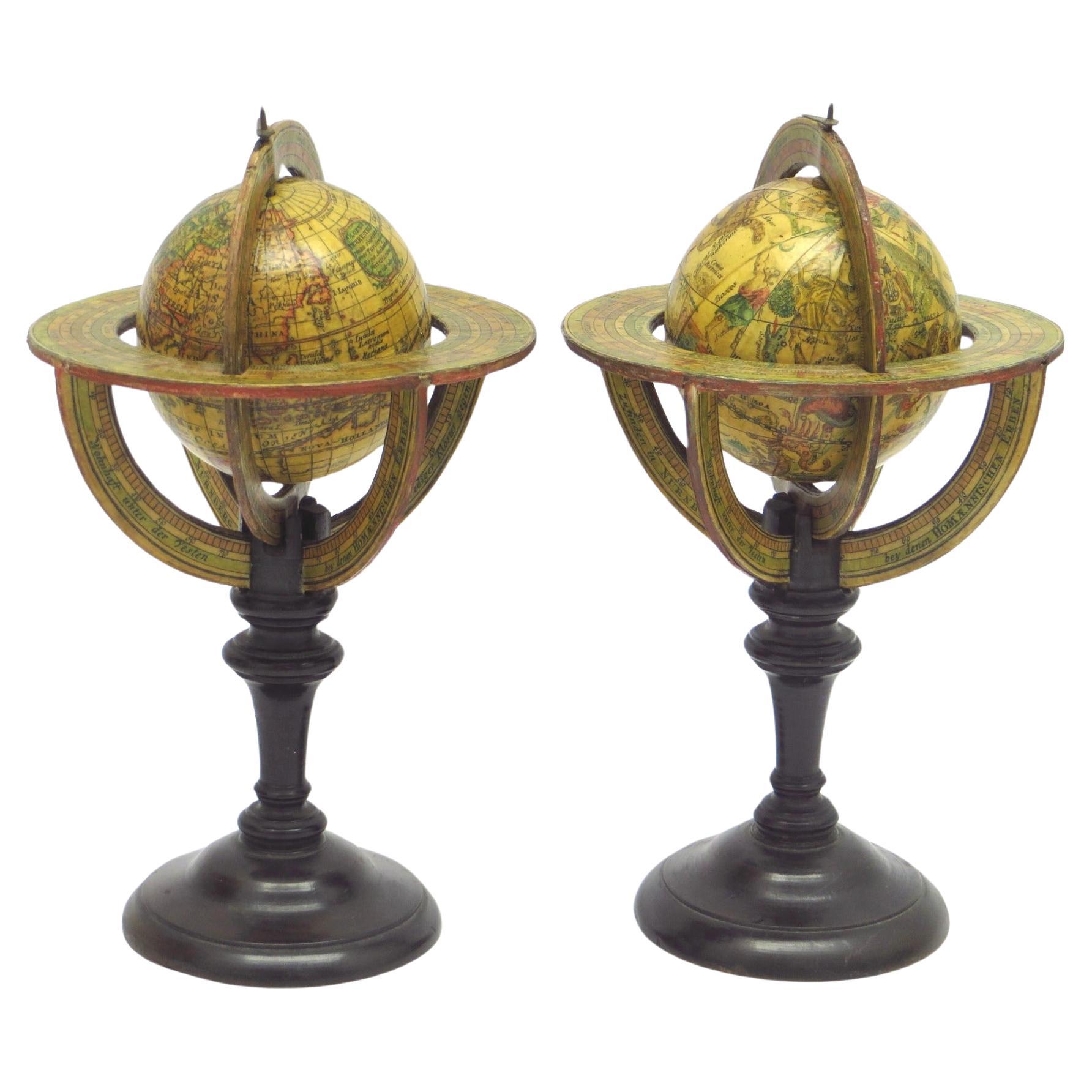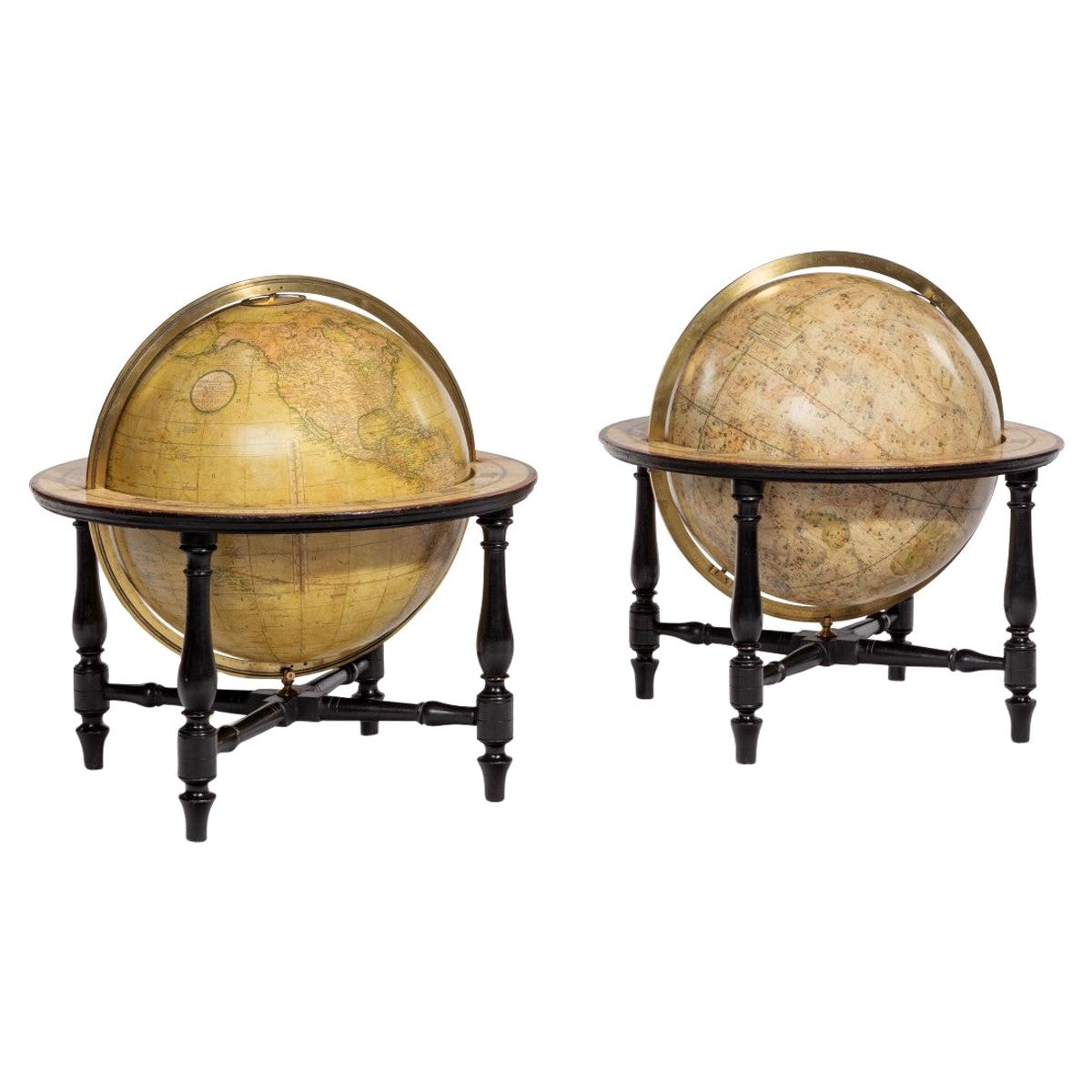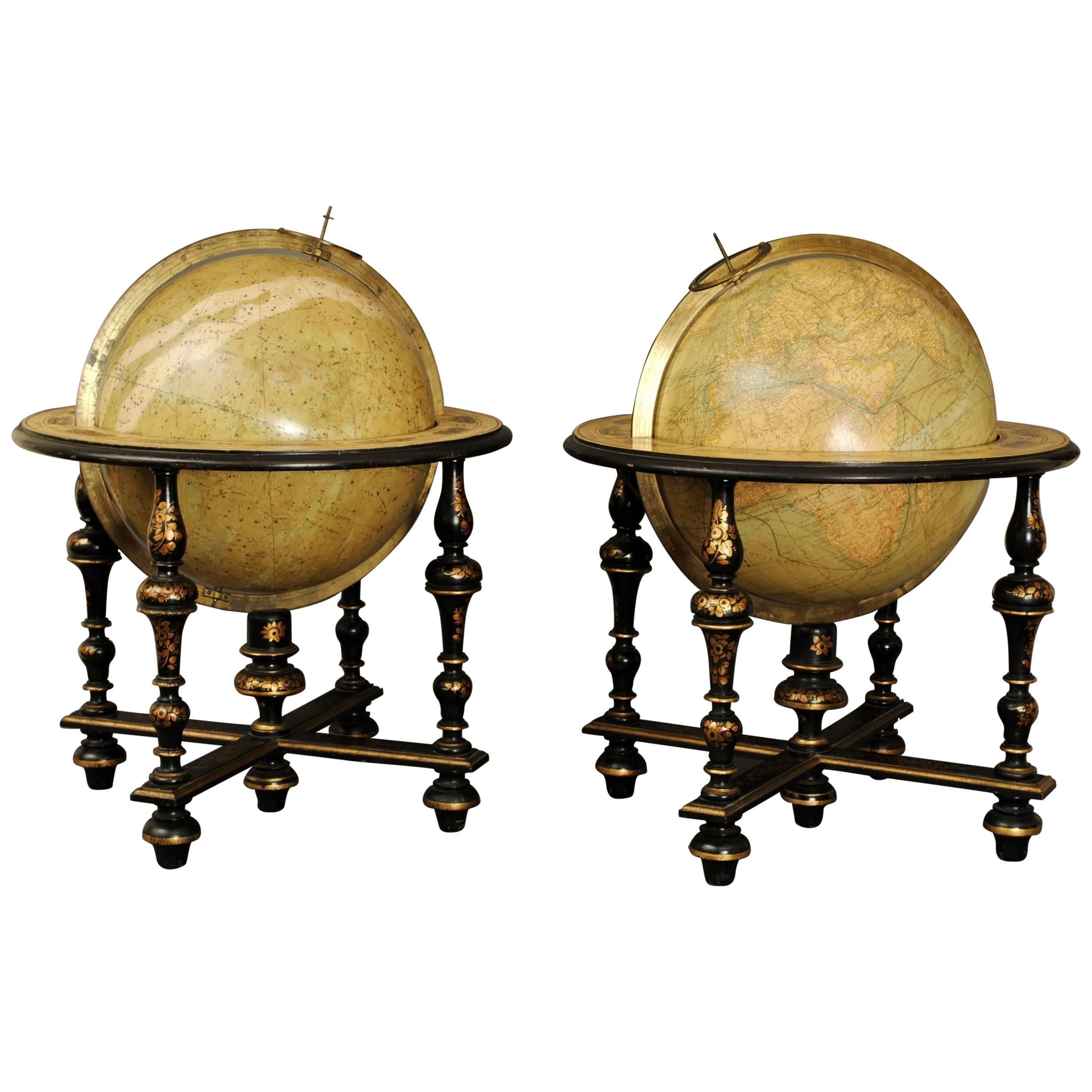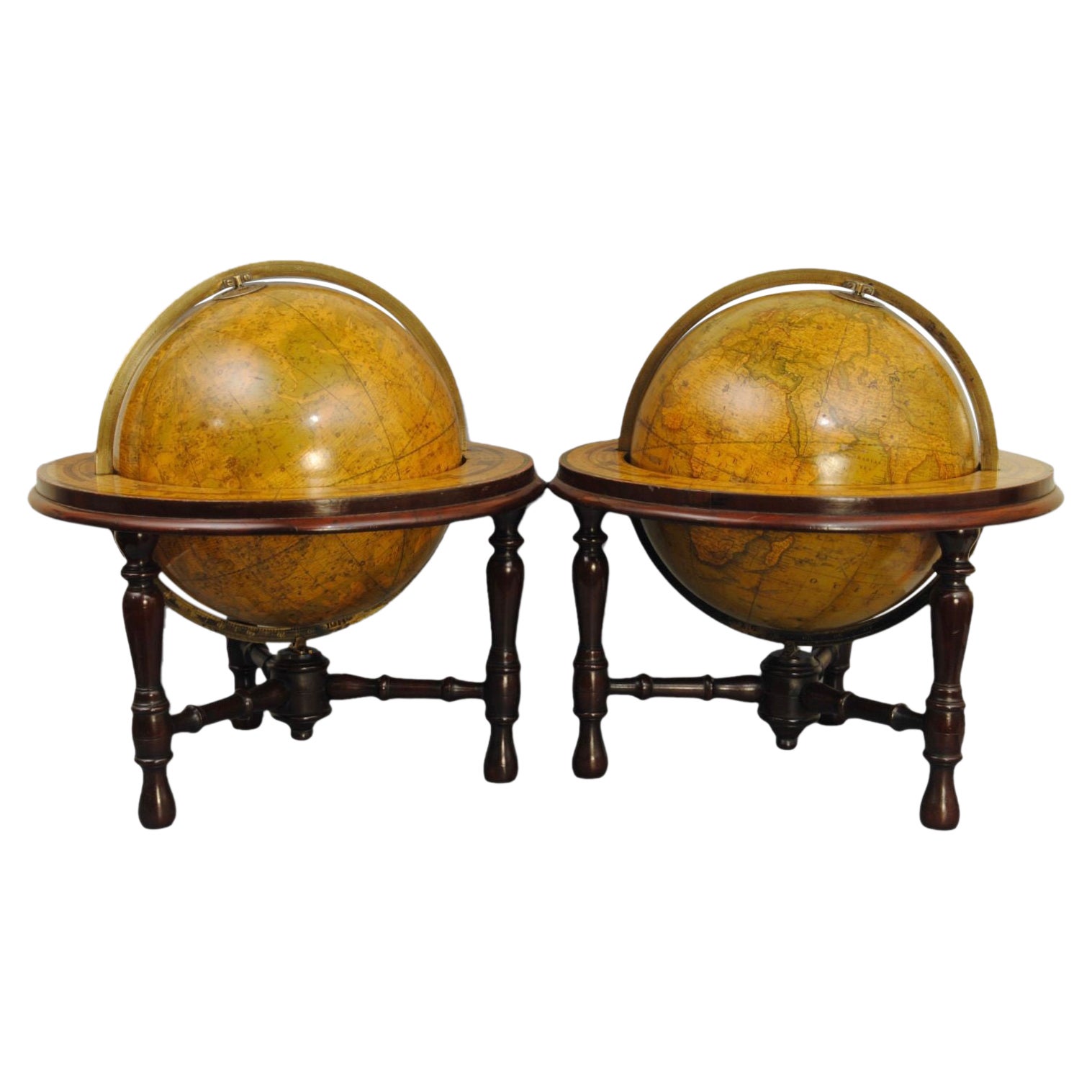Articles similaires à Une paire exceptionnelle de globes de table BLAEU
Chargement de la vidéo
Vous voulez plus d'images ou de vidéos ?
Demander au vendeur plus d'images ou de vidéos
Une paire exceptionnelle de globes de table BLAEU
À propos de cet article
A very rare set of globes, 9 inch / 23cm, with an overall height of 38 cm, Amsterdam, dated 1602, but published after 1621. In their original stands with circular wooden horizon rings, covered with printed paper, supported by four legs and brass meridian rings supported by a single column.
The terrestrial and celestial globe are made up of a set of 12 engraved gores, heightened in gold and Arctic ice caps, printed on paper and mounted on a plaster sphere of papier maché. Each sphere is mounted in a graduated brass meridian ring with the production number stamped at the back of the ring. Both globes are mounted on four-legged ebonized oak Dutch stands, which support the horizon ring. The legs are connected by two crossbeams which support a circular base plate with central support for the meridian ring. The horizon rings are covered with printed paper. With usual defects: paper equinoctial tables present gaps that are filled and restored; small splits along gores; several partially deleted entries; on the globe, the date 1602 and the text of the cartouche in America, are illegible ; small scattered spots but in general in good condition for such an early globe pair of which presently only 19 pair are recorded.
These 9-inch globes are among the rarest since very few copies of them are known to exist, in comparison with the smaller or larger globes of Blaeu (4, 6, 13.5, and 26 inches). Blaeu's terrestrial globes were highly valued and were much in demand, because of the care with which they had been prepared, because of the efforts to give the latest information on discoveries, and because of the loxodromic lines that made them of special value to navigators.
His celestial globes were appreciated for the fact that he had been the pupil of Tycho Brahe, who was himself known to be the greatest astronomer of his time.
Willem Janszoon Blaeu (1571–1638), originally trained in astronomy, he quickly became a leading maker of maps, atlases and instruments. Blaeu’s globes were luxury items for wealthy and intellectual merchants and nobility who benefited from Blaeu’s access through the Dutch East India Company to the latest navigational discoveries and geographical information.
Willem Jansz Blaeu collected information that Dutch mariners gathered from around world and brought back to Amsterdam. Crews were instructed to record information about the lands they visited and the skies they saw. Blaeu incorporated these observations in maps and globes. Through his web of contacts and thanks to assiduous research, he was also able to obtain the most recent information about the latest discoveries in the western hemisphere and the South Pacific, where Dutch explorers were particularly active at the time.
Since the globe was published after 1618, Blaeu was able to include the discoveries made by Henry Hudson in his attempt to find a passage to the East Indies. He also included recent Pacific discoveries of the celebrated voyages of Willem Cornelis Schouten and Jacob Le Maire, who both traversed the South Pacific and the Atlantic. The findings of Schouten and Le Maire in the Tierra del Fuego region are also incorporated.
The Strait of Le Maire is drawn and the hypothetical southern continent is labelled “Terra Australis Incognita Magalanica”. Olivier van Noort’s track is drawn and labelled. His route is indicated with a broken line and the words: “Navigationis Olivierij ductus” (several times). There are various decorative features, such as animals on the different continents, many ships on the high seas and allegorical and mythical figures around the cartouches.
The nine-inch globe is not just a smaller version of the one published in 1599. Drawings of animals and people do often correspond to those on the earlier globe, but Blaeu made several significant changes.
- The west coast of North America is drawn differently and the river system of Brazil is altered.
- The hypothetical southern continent is labelled: Terra Australis Incognita Magallanica.
- There are nine ocean names in handsome curling letters: Mare Congelatum, Mare Atlanticum, Oceanus Aethiopicus, Mare Arabicum et Indicum, Mare di India, Oceanus Chinensis, Mar del Zur, Mare Pacificum, Mar del Nort.
- Willem Blaeu, always eager to display the latest discoveries, traced the route of Van Noort’s route with a broken line. The findings of the voyage of Schouten and Le Maire in the Tierro del Fuego region are included, despite the 1602 date (names: Fr. Le Maire, Mauritius, Staten Landt, C.Hoorn, I.Barneveltij).
The following states are known:
Terrestrial
First state: 1602 (no known examples).
Second state, c1618-1621 (no known examples).
Third state: 1602, but c1621 (the present example).
All the states are dated 1602 but the second state must have been published after 1618, since it includes the discoveries of Schouten and Le Maire (1615–1617), but not the name “Blaeu”.
Elly Dekker makes no distinction between the different states. The third state can be divided into states 3a and 3b. All globes have a different production number, some of which are illegible today. This terrestrial nine-inch globe is marked with “fabr. nr. 4”.
Celestial
First state: 1602 (known in a catalogue record but no known example surviving).
Second state: presumably published after 1621.
All 30 known celestial globes are in the second state, as this one, which is marked with “fabr. no. 12”.
Rare: there are 19 recorded pairs, of which 14 are in institutions.
Bibliography
Van der Krogt, Globi Neerlandici BLA III
Dekker GLB0152, GLB0083 (terrestrial) and GLB0151 (celestial).
- Créateur:Willem Blaeu (Designer)
- Dimensions:Hauteur : 38,1 cm (15 po)Diamètre : 22,86 cm (9 po)
- Vendu en tant que:Lot de 2
- Style:Colonial hollandais (De la période)
- Matériaux et techniques:
- Lieu d'origine:
- Période:XVIIe siècle
- Date de fabrication:1602
- État:Réparé: The hour circles are renewed, the space between the gores are filled up at some places, the gold on the compass roses has been complemented. Usure conforme à l'âge et à l'utilisation. In general in good condition for such an early globe pair.
- Adresse du vendeur:ZWIJNDRECHT, NL
- Numéro de référence:1stDibs : LU9419237294302
À propos du vendeur
Aucune évaluation pour le moment
Vendeur agréé
Ces vendeurs expérimentés font l'objet d'une évaluation complète par notre équipe d'experts.
Vendeur 1stDibs depuis 2023
- ExpéditionRecherche du devis...Expédition à partir de : ZWIJNDRECHT, Pays-Bas
- Politique des retoursCet article peut être retourné sous 14 jours à compter de la date de livraison.
Certaines parties de cette page ont été traduites automatiquement. 1stDibs ne garantit pas l'exactitude des traductions. L'anglais est la langue par défaut de ce site web.
Plus d'articles de ce vendeurTout afficher
- Paire extrêmement rare de globes miniatures de Johann Baptist HomannPar Johann Baptist HomannJ.H. Homann (Allemagne, 1664-1724) Nürnberg, après 1715 Globus Terrestris [et] Globus Celestis. juxtu observationes Parisienses Regia Academia Scientiarum constructus [et] juxtu obs...Catégorie
Antiquités, années 1710, Allemand, Colonial hollandais, Globes
MatériauxAutre
- Une paire de globes de table Valk extrêmement raresPar Gerard and Leonard ValkTitre sur les globes : VALK, Gerard et Leonard. [Globe terrestre :] Cosmotheore, caelesti nostro globo, par, et plane novus, hic terrestris ut existeret, certo scias, errore veterum ...Catégorie
Antiquités, XVIIIe siècle, Néerlandais, Colonial hollandais, Globes
MatériauxAutre
- Une paire de globes de table décoratifs rares en bon état.Par Johann Gabriel DoppelmayrCette paire de globes, datée de 1730, est originale et en bon état. Titre : Globus terrestris novus LoCa Terrae insigniora sec. praestant Astron. et Geogr. observationes sistens ope...Catégorie
Antiquités, Début du XVIIIe siècle, Allemand, Baroque, Globes
MatériauxAutre
- Un magnifique globe de table céleste produit par Gerard & Leonard ValkPar Gerard and Leonard ValkMagnifique et très rare globe de table céleste du début du XVIIIe siècle produit par Gerard et Leonard Valk. Établie à la fin du siècle précédent par Gerard Sons, assisté de son fils...Catégorie
Antiquités, Début du XVIIIe siècle, Néerlandais, Colonial hollandais, Gl...
MatériauxAutre
- Magnifique globe à double pochePar Carl BauerEditeur : Carl Bauer (Allemagne, 1780-1857) Lieu / Date : Nürnberg, vers 1840 Taille : Diamètre des globes 6,5 cm. Globe terrestre et globe céleste "Mère et Enfant" ou doub...Catégorie
Antiquités, années 1840, Allemand, Colonial hollandais, Globes
MatériauxBois, Papier
- Une belle paire de globes miniatures sur des standsPar Karl MullerUne paire rare de globes terrestres et célestes miniatures. par K.K. Müller, 1822 Karlsruhe, Allemagne Diamètre des globes : 7 cm. Hauteur totale : 14,5 cm. Chacune d'entre elles...Catégorie
Antiquités, Début du XIXe siècle, Allemand, Style international, Globes
MatériauxBois de feuillus, Papier
Suggestions
- Paire de globes de table Cary'sPaire de globes de table de 15 pouces de Cary, chacun monté sur un support en ébène avec quatre pieds tournés et des brancards, le terrestre portant la mention "Cary's New Terrestria...Catégorie
Antiquités, Début des années 1800, Anglais, Globes
MatériauxÉbène
- Superbe paire de globes de table DelamarcheUne merveilleuse paire de globes de table du 19ème siècle par la Maison Delamarche Paris, en superbe état d'origine. Les globes de 12" dans leurs supports originaux laqués et décorés...Catégorie
Antiquités, années 1860, Français, Globes
- Paire de globes de table de J & W Newton, daté de 1820Par John & William NewtonUne paire de globes de table de 12 pouces par J & W Newton, datés de 1820, chacun avec 12 gores colorés à la main, des anneaux méridiens gradués, placés dans des supports ébonisés av...Catégorie
Antiquités, années 1820, Anglais, Regency, Globes
MatériauxBois
- Paire de globes de table du XIXe siècle par CrunchleyUne paire de globes de table de 12" par le célèbre fabricant de cartes Crunchley, Londres. Dans les supports originaux et très élégants en acajou. Circa 1865.Catégorie
Antiquités, XIXe siècle, Anglais, Globes
MatériauxAcajou, Papier
- Rare paire de globes de table de Cary, chacun daté de 1816Par John & William CaryUne paire rare de globes de table de 9 pouces par Cary, chacun daté de 1816. Ces globes sont l'œuvre de John et William Cary et montrent les frontières géographiques et politiques ét...Catégorie
Antiquités, années 1810, Anglais, Globes
MatériauxLaiton
- Paire de globes de table de G & J Cary, datés de 1800 et 1821Par George & John CaryUne paire de globes de table de 12 pouces par G & J Cary, datés de 1800 et 1821, chacun avec des gores peints à la main, placés dans des supports en acajou avec un support tourné rep...Catégorie
Antiquités, Début du XIXe siècle, Anglais, Globes
MatériauxAcajou





